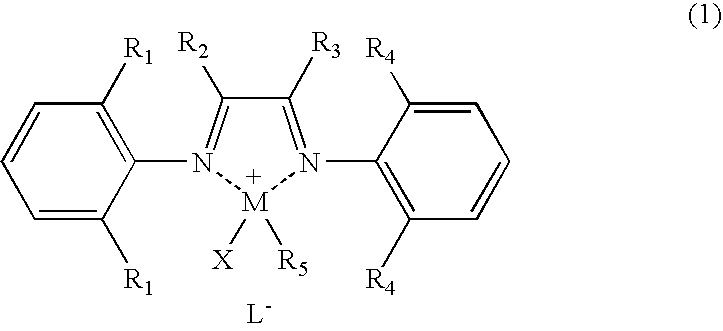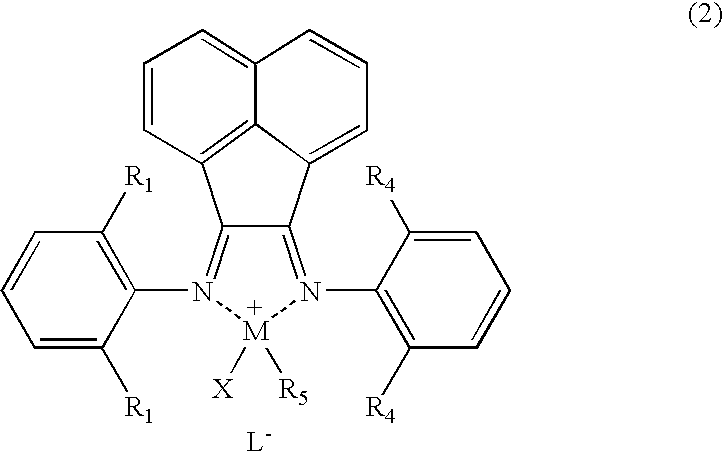Polyolefin graft copolymer prepared in the presence of coordination polymerization catalyst based on late transition metal complex and method for making the same
a technology of coordination polymerization and polymerization catalyst, which is applied in the field of polyolefin graft copolymer prepared in the presence of a coordination polymerization catalyst based on a late transition metal complex, can solve the problems of catalyst not readily reacting with polar compounds, catalysts that are not readily decomposable, and low grafting efficiency, etc., to achieve high impact resistance and high transparency
- Summary
- Abstract
- Description
- Claims
- Application Information
AI Technical Summary
Benefits of technology
Problems solved by technology
Method used
Image
Examples
synthetic example 1
[0045]In a 1-L separable flask equipped with a reflux tube and a stirrer, CuBr (3.6 g, 0.025 mol) was charged, and the interior of the reaction vessel was purged with nitrogen. Acetonitrile (62 mL) was added, and the mixture was stirred for 15 minutes at 70° C. in an oil bath. Butyl acrylate (36 mL, 0.25 mol), ethyl acrylate (50 mL, 0.46 mol), 2-methoxyethyl acrylate (37.5 mL, 0.29 mol), diethyl-2,5-dibromoadipate (15.0 g, 0.042 mol), and pentamethyldiethylene triamine (0.22 mL, 0.18 g, 1.05 mmol) (hereinafter simply “triamine”) were added to the resulting mixture to initiate reaction. Butyl acrylate (144 mL), ethyl acrylate (200 mL) and 2-methoxyethyl acrylate (150 mL) were gradually added dropwise to the mixture over 210 minutes with stirring at 70° C. In the course of dropping the monomers, additional triamine (0.76 mL, 0.63 g, 3.7 mmol) was added. 330 minutes after the initiation of the reaction, 1,7-octadiene (124 mL, 92 g, 0.84 mol) and triamine (2.6 mL, 2.2 g, 0.013 mol) were...
synthetic example 2
[0047]A stirrer and a nitrogen line were attached to a 2-L separable flask. The flask was vacuumed using a vacuum line to dry the interior, and the pressure was returned to normal by purging nitrogen. Subsequently, methylene chloride (337 mL) and methylcyclohexane (447 mL), i.e., solvents, dried by molecular sieve treatment were introduced into the flask in a nitrogen flow. The flask was immersed in a dry ice-ethanol bath to cool the contents of the flask to −71° C. Isobutylene (109 g, 1,936 mmol) was introduced into the flask using pressure-glass liquefied gas collecting tube equipped with a needle valve connected to an isobutylene bottle. Methylene chloride / methylcyclohexane (5.6 mL / 7.4 mL) prepared by dissolving cumyl chloride (3.88 mmol) and α-picoline (3.88 mmol) was added to the mixture. Subsequently, TiCl4 (13.25 g, 69.8 mmol) was added to initiate polymerization. Fifty minutes after the initiation of the polymerization, allylsilane (0.443 g, 3.88 mmol) was added. The reactio...
synthetic example 3
[0048]Distilled water (35.4 mL), butyl acrylate (8.0 g), ethylene glycol dicyclopentenylether methacrylate (0.33 g), and stirrer chips were placed in a 300-mL four-necked flask equipped with a cooling tube and a three-way cock. Nitrogen bubbling was performed for 25 minutes to yield nitrogen atmosphere. Sodium dodecyl sulfate (0.9 g) was added to the mixture, and the mixture was stirred for ten minutes using a powerful magnetic stirrer to prepare an emulsion. The oil bath was set to a temperature of 85° C., and an ammonium persulfate / distilled water (0.016 g / 0.16 mL) solution was added to the emulsion when the temperature of the flask content reached 74° C. to initiate polymerization. After 50 minutes, heating by using the oil bath was discontinued, and the reaction mixture was cooled to terminate the polymerization. The volume-average particle diameter (according to NICOMP) of the latex obtained was 36 nm (97%) and 106 nm (3%). The yield was 98%, and the solid content (SC) was 20.3...
PUM
| Property | Measurement | Unit |
|---|---|---|
| molecular weight distribution | aaaaa | aaaaa |
| molecular weight distribution | aaaaa | aaaaa |
| molecular weight distribution | aaaaa | aaaaa |
Abstract
Description
Claims
Application Information
 Login to View More
Login to View More - R&D
- Intellectual Property
- Life Sciences
- Materials
- Tech Scout
- Unparalleled Data Quality
- Higher Quality Content
- 60% Fewer Hallucinations
Browse by: Latest US Patents, China's latest patents, Technical Efficacy Thesaurus, Application Domain, Technology Topic, Popular Technical Reports.
© 2025 PatSnap. All rights reserved.Legal|Privacy policy|Modern Slavery Act Transparency Statement|Sitemap|About US| Contact US: help@patsnap.com


